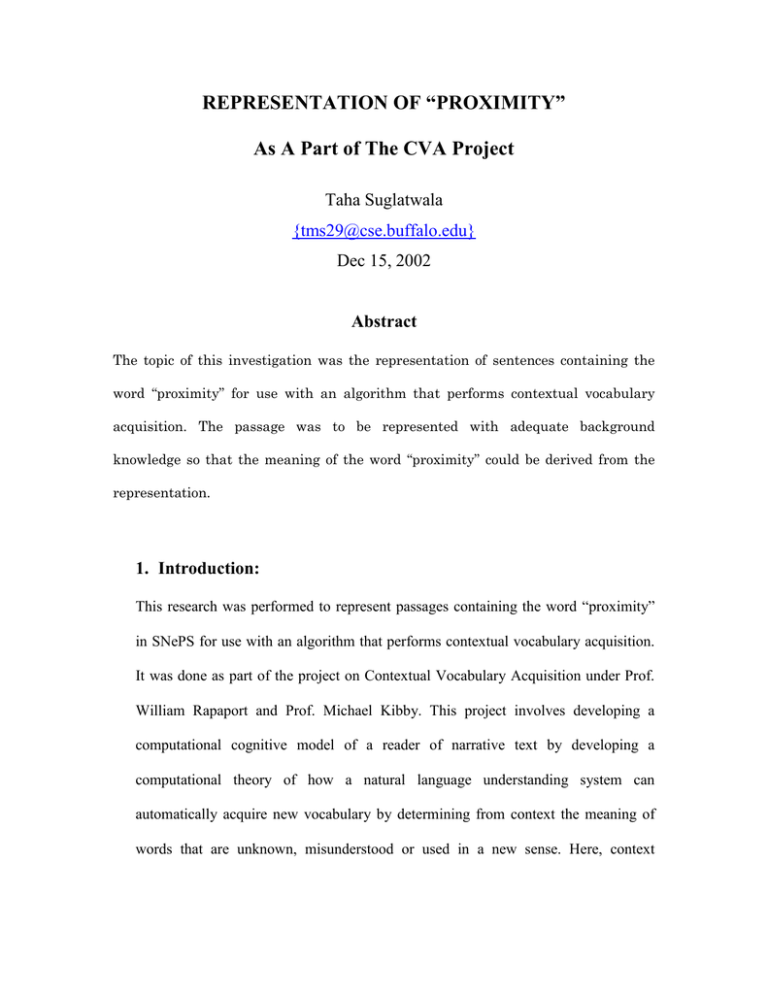REPRESENTATION OF “PROXIMITY” As A Part of The CVA Project Abstract
advertisement

REPRESENTATION OF “PROXIMITY”
As A Part of The CVA Project
Taha Suglatwala
{tms29@cse.buffalo.edu}
Dec 15, 2002
Abstract
The topic of this investigation was the representation of sentences containing the
word “proximity” for use with an algorithm that performs contextual vocabulary
acquisition. The passage was to be represented with adequate background
knowledge so that the meaning of the word “proximity” could be derived from the
representation.
1. Introduction:
This research was performed to represent passages containing the word “proximity”
in SNePS for use with an algorithm that performs contextual vocabulary acquisition.
It was done as part of the project on Contextual Vocabulary Acquisition under Prof.
William Rapaport and Prof. Michael Kibby. This project involves developing a
computational cognitive model of a reader of narrative text by developing a
computational theory of how a natural language understanding system can
automatically acquire new vocabulary by determining from context the meaning of
words that are unknown, misunderstood or used in a new sense. Here, context
includes surrounding text, grammatical information and background knowledge, but
no access to external sources of information (such as a dictionary or human). [1]
Prior Work on “Proximity”:
Some prior work was done on this word by Valerie Yakich and Scott Napieralski.
Valerie Yakich did a preliminary representation of 3 passages containing the word
proximity. However these representations introduced a very large number of new case
frames. These were then run on Karen Ehrlich’s noun algorithm. Since the Ehrlich
algorithm did not recognize the new case frames, it was required to re-encode these
passages. Scott Napieralski did precisely this in May 2002. [2]. Though his
representations of “proximity” were better than that of Yakich, the results after
running these were not satisfactory enough. Hence it was required that more passages
on “proximity” be represented, so that we could determine if it is possible to learn
more from the context.
2. My role in the project:
I was given the following passage to represent in SNePS:
My Passage:
Exposure has been defined in various ways in the past. For example, an Institute of
Medicine report (IOM, 1994) defines exposure as “the concentration of an agent in
the environment in close proximity to a study subject.”
(Clearing the Air: Asthma and Indoor Air Exposures (2000), Institute of Medicine.)
In the course of representing the above passage containing the word “proximity”, a
number of compromises were made, and the information that was finally represented
in SNePS was not the same as that described in the passage. This was because a large
part of the passage consisted of matter that was irrelevant to the representation of the
meaning of “proximity”. Hence my rendering of the passage was as follows:
“Exposure is defined as the concentration of an agent in the environment in close
proximity to a study subject.”
Here, we assume that all words other than “proximity” are well understood by the
system. There are two key points in this particular passage:
1. The passage is a definition of the word ‘exposure’. Hence it expects us to fully
understand all words other than ‘exposure’. However in our representation we assume
that we fully understand all words except ‘proximity’. Hence we need to provide
adequate background knowledge on ‘exposure’, so that we could define ‘proximity’
in terms of it.
2. A second key point in this passage was the phrase ‘close proximity’. As was
adequately exhibited by the think aloud protocols on this passage, even if the word
“proximity” was replaced by a dummy word “quazonity”, the subject of the protocol
managed to guess that the meaning of “quazonity” must be something like nearness
because of the word “close” in front of it.
Hence it was with these two points in mind that I went about representing the passage
in SNePS.
Analysis of Think-Aloud Protocols:
Two think-aloud protocols on the word proximity were thoroughly analyzed before
the representation of the passage took place. Unfortunately, the protocols did not help
too much since the subjects guessed the substitute words’ meaning as proximity in the
first attempt itself. This was perhaps due to the phrase ‘close quazonity’ where
quazonity was the word used to substitute ‘proximity’ in the original passage. Perhaps
the subjects were already familiar with the phrase ‘close proximity’ and so did not
have much problem recognizing the meaning of quazonity.
(Think-Aloud Protocol involving subject CB and MB)
However their think aloud protocols for other passages on ‘proximity/quazonity’
yielded some interesting points. From most of them, we could conclude that the
subject had an idea that proximity meant something like nearness, or something
related to distance. Hence it was concluded that perhaps Cassie would also draw the
same conclusion.
3. My Work so far:
I have focused mainly on the representation of the passage. This representation is
shown below:
M1!
M7
object1
rel
object2
object2
member
M2
lex
1
Ex
“exposure”
po
M3
! NEW!
---NEW NEW NEW NEW NEW NEWM4!
NEW
lex
class
lex
“subject”
rel
“define”
B1
M8
M6
object
lex
ha
object
member
lex
M10!s
M9!
be
en
def
M5!
object1
sur
e
lex
“living
organism”
object
M14!
“proximity”
property
ine
d
class
M13
in
location
lex
var
iou
s
M15
M17
lex
“concentrated”
wa
“agent”
ys
“environment”
in
location
the
pa
lex
st.
For
ex
am
ple
,
M12
The word “proximity” is represented as a relation between the agent and the study
subject. The representation describes the definition of the word ‘exposure’, which is
defined as the proposition that an agent is related to a study subject by the relation
“proximity”. The agent is located in the environment and has the property of being
concentrated. Note that “the concentration of an agent” has been interpreted as “the
concentrated agent” in the representation. Besides this, the study subject is assumed
to also be in the same environment and is considered to be a member of the class of
living organisms.
The basic weakness of the above representation is that though it very adequately
describes the given passage, it does not give out the meaning of the word “proximity”
clearly.
Hence I needed to include some background knowledge as well as a few rules, which
would allow the system to infer that proximity in fact means nearness or closeness.
New Case Frame:
Syntax: If i, R and j are individual nodes and ‘M’ is an identifier not previously used
then:
M!
object
object
relation
j
i
R
is a network and M is a structured proposition node.
This is the object – rel – object case frame.
Semantics: M is the proposition that i is related to j and j is related to i by the relation
R. Hence the relation is commutative, that is, it holds in both directions.
The rest of the case frames are old case frames taken from Scott Napieralski’s
Dictionary of CVA SNePS case frames [3].
Background Knowledge Rules:
1. If x is related to y by ‘exposure’, then x and y are near each other.
M1!
ant
cq
M2!
object1
M3!
object2
rel
object
Y
X
object
rel
X
exposure
Y
near
This background knowledge rule would allow the system to infer that if an object
is exposed to another object, then it must be near that object.
2. If x and y are located in the same environment then they are near each other.
M1!
&ant
&ant
M2!
object
cq
M3!
location
object
M4!
location
object
object
rel
X
Environ
ment
Y
Environ
ment
X
Y
near
This rule again affirms the fact that if two objects lie in the same environment
then they must be near each other. Note that, this implies that, in our passage, the
agent and the study subject are near each other.
3. If x and y are near each other then they are close to each other.
M1!
ant
cq
M2!
object
X
M3!
object
rel
Y
object
X
near
object
rel
Y
close
This rule is a very simple rule that indicates that if something is near something
else, then the 2 things are also close to each other. This will help us induce that
the study subject and the agent are close to each other.
4. If x is in p to y then x is close to y.
M1!
ant
cq
M2!
object1
X
rel
p
M3!
object2
Y
object
X
object
rel
Y
close
Finally this rule indicates that if an object x is in relation p to another object y
then x is also close to y. The relation p is a generic relation from which other
relations such as proximity can be reduced. Abductive reasoning will be used in
this case to show that since, according to rules 1,2 and 3, x and y are close to each
other – then according to rule 4, they might be related by relation p. With respect
to our specific example, this indicates that since we know that the agent and the
study subject are lying close to each other, they may possibly be linked by the
relation ‘proximity’. This rule connects all the different ideas expressed above by
linking the relation ‘proximity’ with closeness and degree of separation.
Hence we can get the following rule:
For all x, y, z, if x is near y and if x is close to y then possibly, x is in close z to y.
M1
&ant
&ant
M2!
object
X
M3!
object
rel
near
cq
Y
object
X
rel
M4
object
Y
close
object
X
object
rel
Y
Close z
The above rule says that if x is near y and x is close to y then they might be connected
by the relation of being in close z to each other. Thus by abductive reasoning we’ll
come to know that proximity means closeness.
Thus we have completely represented the given passage with the word “proximity”.
4. Work for the Immediate Future:
Perhaps the most important goal for the immediate future would be to encode the
above representation in SNePS and then run it through the noun algorithm to check
whether it gives the correct results. Secondly, perhaps there is some scope to work on
the background knowledge representation, since there could be a better way to
represent that. However it is a tricky issue, and also a very subjective one, and so a
representation that seems right to one person, may not seem so to others.
5. Work for the Long Term Future:
In the future, researchers working on “proximity” should encode several more
passages to determine if it is possible to learn more about this word from context. A
word such as “proximity” provides a unique challenge to the algorithm since several
methods used by the algorithm to find a definition, such as listing structures and
functions, do not apply to this word. This is because it is not a physical object so it
does not have any structure or functions. It may be that the algorithm does the best
possible job of generating a definition, but it may also be that there are additional
types of information that apply to nouns which are not physical objects.
It would also be useful if future researchers could look into other ways of
representing “proximity” other than using the object1 – rel - object2 case frame as
used in this work and in the works of previous researchers.
6. References:
1. William J. Rapaport and Karen Ehrlich. “A Computational Theory of Vocabulary
Acquisition”, 1998.
2. Scott Napieralski. “Representation of ‘Proximity’ for Evaluation by a Contextual
Vocabulary Acquisition Algorithm”, 2002.
3. William J. Rapaport and Michael Kibby. “Contextual Vocabulary Acquisition: A
Computational Theory and Educational Curriculum”, 2002.
4. Scott Napieralski’s CVA Case Frame Dictionary:
http://www.cse.buffalo.edu/~stn2/cva/case-frames/index.html







